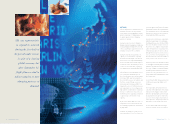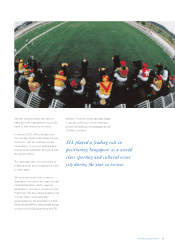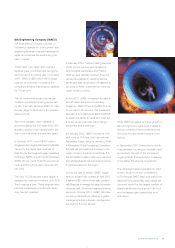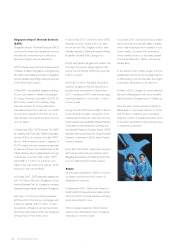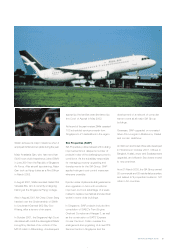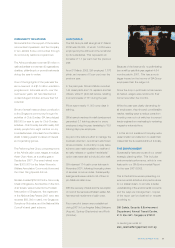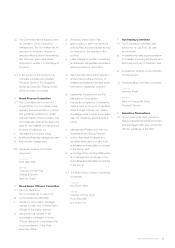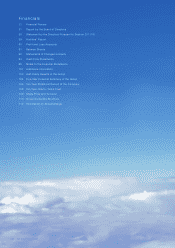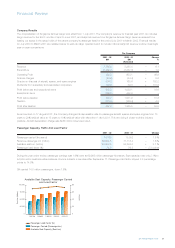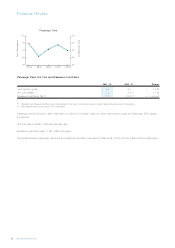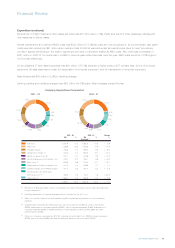Singapore Airlines 2002 Annual Report Download - page 29
Download and view the complete annual report
Please find page 29 of the 2002 Singapore Airlines annual report below. You can navigate through the pages in the report by either clicking on the pages listed below, or by using the keyword search tool below to find specific information within the annual report.
OUR PEOPLE
The SIA Group’s staff strength at 31 March
2002 was 29,604, of which 14,254 were
employed by the Airline and the remainder
by its subsidiaries. This represents an
increase of 1.7 per cent over the previous
year.
As at 31 March 2002, SIA employed 1,776
pilots, an increase of 8 per cent over the
previous year.
In the past year, SIA and SilkAir recruited
148 cadet pilots and 114 captains and first
officers, while 81 pilots left service, resulting
in a net increase of 181 during the year.
Pilots spent nearly 11,000 crew days in
training.
SIA’s heavy investment in staff development
generated 3.1 training places for every
employee during the year, translating to 15.9
training days per employee.
As part of the Airline’s effort to manage the
business downturn, recruitment was frozen
where possible. A voluntary no-pay leave
scheme was made available to staff and
an early release or “golden handshake”
option was extended to include junior staff.
SIA released 114 cabin crew trainees in
November 2001, following the scaling down
of services on some routes. Subsequently,
arrangements were made for 35 of them to
join SilkAir as cabin crew.
With the recovery of loads and the resumption
of most of the services withdrawn earlier, SIA
has resumed recruitment of cabin crew.
Four new pilot bases were established
during 2001 in Los Angeles (May), Brisbane
(August), Sydney (September) and Perth
(October).
Because of the lower profit, no profit-sharing
bonus will be paid this year, against 4.54
months paid in 2001. This has a much
bigger impact on the income of SIA Group
employees than the wage cut.
Since the drop in profit was not as severe
as feared, wages were restored to their
former level after five months.
While the year was clearly demanding for
all employees, they showed considerable
resolve, seeking ways to reduce costs from
inventing new cut-out switches to prevent
tractor engines from overheating to reviewing
magazine subscriptions.
It is this kind of sustained Company-wide
determination and attention to detail that
makes SIA the successful airline it is today.
THE ENVIRONMENT
Sustainability has been a part of our overall
strategic planning effort. This includes
environmental performance, which is now
featured in our SIA Environmental Report
for the year 2001/2002.
This is the first time we are presenting our
environmental activities and performance
to our stakeholders, to provide a better
understanding of the environmental concerns
and the ways we manage them. Copies
of the report can be obtained on request
by writing to:
SIA Safety, Security & Environment
Department, Airmail Transit Centre,
P. O. Box 501, Singapore 918101
or sending an email to:
alex_desilva@singaporeair.com.sg
COMMUNITY RELATIONS
SIA benefits from the support of the broader
communities it operates in, and the Company
in turn assists those communities through
its community relations programmes.
The Airline contributed more than $1 million in
cash and airfares to more than 40 organizations,
charities, philanthropic or promotional events
during the year in review.
One of the highlights of the year was the
announcement of a $1.5 million education
programme in Indonesia which, over the
next seven years, will help talented but
underprivileged children achieve their full
potential.
SIA and its staff made a direct contribution
to the Singapore community through the
activities of Club Sunday. SIA has pledged
$96,000 a year to pay for Club Sunday
activities. Club Sunday benefits nearly 500
elderly people from eight centres run by
Lions Befrienders. Volunteers from the Airline
assist in taking guests to places of interest
and organizing games.
The Performing Arts Circle, comprising some
of the Airline’s cabin crew, staged a musical,
Heart Over Heels, at a charity gala in
September 2001. The event raised more
than $300,000 for the Asian Women’s
Welfare Association Community Home and
the Chao Yang Special School.
SIA also donated $150,000 to the Community
Chest of Singapore. Sponsorship, in the form
of air tickets, was provided to the Football
Association of Singapore, the organizers
of the National Day Parade 2001 (who also
received $50,000 in cash), the Singapore
Symphony Orchestra, and the National Arts
Council’s travel grant scheme.
SIA Annual Report 01/02 29




